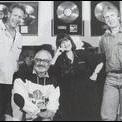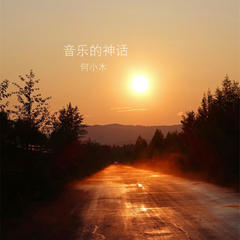The Seekers
by Bruce EderAlthough its difficult for those who werent there to believe, for a short time during late 1965 and early 1966, the popularity of this singing quartet from Australia was sufficient to rival the Beatles and the Rolling Stones. The Seekers were at the head of the British Invasions acoustic folk-rock division, right there with Peter & Gordon and Chad & Jeremy but without the personal Beatles connection of the former and more successful than either — they scored a string of number one hits in England and Top Ten successes in America that lasted into 1967, two years later than most of the rest of the British exports to this country. They played acoustic instruments (even the upright bass), and they were closer in image and inspiration to the likes of the Rooftop Singers (Walk Right In), the New Christy Minstrels (Green Green, etc.), or Peter, Paul & Mary, than to the Beatles or even the Searchers, yet they managed to hang onto young listeners, as well as older teenagers and their parents, with songs like Ill Never Find Another You, A World of Our Own, Come the Day, or Georgy Girl. The Seekers were formed in Australia in 1963 by Athol Guy (vocals, bass; b. Jan. 5, 1940, Victoria, Australia), Keith Potger (vocals, 12-string guitar; b. Mar. 2, 1941, Colombo, Sri Lanka), Bruce Woodley (vocals, guitar; b. July 25, 1942, Melbourne, Australia), who had all attended Melbourne Boys High School together. Potger had led a band in the late 1950s called the Trinamics, doing covers of Buddy Holly, Eddie Cochran et al, while Guy had led a band called the Ramblers. The breakup of both groups got the two of them together with Woodley and a singer named Ken Ray, and they formed a doo wop outfit called the Escorts. By 1963, the folk boom that had started sweeping America and England in 1959 had made its way to Australia, and the Escorts evolved into the Seekers. By late that year, theyd met Judith Durham (b. July 3, 1943, Melbourne), who worked at the same advertising agency where Athol Guy had his day job. Shed been born with perfect pitch and had intended to sing opera until she was bitten by the jazz bug in the mid-1950s. Durham already had records out, backed by Frank Traynors Jazz Preachers on the W&G label, but was willing to try singing folk music on the nights she wasnt singing jazz. She was quickly worked into the group as a sort of fifth Seeker. Ray was gone in fairly short order, as Durham took his place as lead singer, and her membership in the group got them a recording contract with W&G Records. Fate played a hand in early 1964 when the Seekers were offered a chance to perform on board a ship for a years worth of international cruises. This got them to London in May of 1964 for a ten-week stay — they had already sent copies of their recordings ahead of them, and when they arrived, they discovered that one of the top talent agencies in London was not only prepared to represent them, but, on the strength of those recordings, had already booked them. A series of London gigs followed, along with a new recording deal with World Record Club, the mail-order division of EMI Records. The cruise performances were abandoned, and two albums in quick succession followed for World Record Club, along with a very choice gig performing on the televised Sunday Night at the London Palladium. Their new agent, Eddie Jarratt, brought them to the attention of Tom Springfield, brother of Dusty and an ex-member of the folk-singing trio the Springfields. He saw in the Seekers a chance to extend the work hed done with the Springfields, and, with Jarratt, formed a production company that signed the Seekers up. Springfield became their resident producer and songwriter. The group was signed directly to EMIs prestigious Columbia Records imprint (no relation to the Columbia label in America), and their first single, Ill Never Find Another You, written by Springfield, got to number one in England and number four in America. A World of Our Own got to number three in England and number 19 in America, and their third, The Carnival Is Over, became their biggest-selling single in England, moving over 93,000 copies in a single day and reaching the top spot on the charts, although it never charted in America. During 1965, the group had made the acquaintance of a young American folksinger living in London named Paul Simon, who also collaborated with Bruce Woodley — the one composer within the performing ranks of the Seekers — on the writing of one song, Red Rubber Ball. The Seekers fourth single, a cover of Simons Someday One Day, only got to number 11 in early 1966, but it was Simons first British success as a songwriter, and his first success as a composer separate from the work of Simon & Garfunkel. The groups sound was based in folk music, but had the polish and some of the flash of folk-rock. They didnt even have an electric bass, but the soaring harmonies, coupled with Keith Potgers powerfully strummed acoustic 12-string and Woodleys emphatic 6-string playing, gave them a sound not too far removed from that of the Searchers, and not out of place in a musical era dominated by the sounds of the Beatles acoustic period (In My Life, Michelle, etc.), the Byrds, the Beau Brummels, et al. Their albums, which included covers of contemporary folk compositions as well as new arrangements of traditional songs, were somewhat more uneven and didnt sell as well. But as singles artists, the Seekers popularity was enormous, rivaling that of the Beatles and the Rolling Stones. Georgy Girl, written by Springfield and actor/composer Jim Dale (Barnum) for the film starring Lynn Redgrave, James Mason, and Alan Bates, was their biggest American success, released late in 1966 and reaching number two in early 1967. The groups British album Come the Day, released late in 1966, was slightly reconfigured with the addition of the hit and released in America as Georgy Girl, probably the best of all their LPs, containing a stunning array of originals by Springfield and Woodley, and superb covers of songs such as Tom Paxtons The Last Thing On My Mind. By this time, however, changing tastes in America were starting to catch up with the Seekers. They enjoyed hits of differing proportions on both sides of the Atlantic with Morningtown Ride, and had two more chart singles in England, their days as a top-selling recording act in the United States were clearly numbered. It didnt have to be that way — theyd had the chance to perform at the 1967 Academy Awards ceremonies that spring, which would have allowed them to be seen by tens millions of Americans, but they had concert obligations in England. By the time the first whiffs of the druggy Summer of Love wafted over the Monterey Pop Festival (where the Seekers didnt appear, but Simon & Garfunkel did), along with the echoes of psychedelic blues, the Seekers were on the wrong side of the musical divide — Simon & Garfunkel bridged the gap between teenagers and their parents, seeming cool to the former and pleasant to the latter, but the Seekers were losing the kids in America. Their upbeat pop sound seemed increasingly out of touch with the darkening mood in the United States, especially among the kids. In England, however, the groups commercial fortunes continued into 1968 and beyond. Their 1968 concert album, Live at Talk of the Town — which showed them less a folk group than a pop outfit — got to number two and became their best-selling British album to date. The company followed this with The Best of the Seekers, which reached number one in 1969. By that time, Judith Durham had decided to leave, and the group was officially disbanded in early 1969 following a farewell concert that was broadcast on British television. As it turned out, the Seekers didnt quite vanish. Keith Potger organized and managed a group christened the New Seekers, with an entirely new membership, who cultivated the same audience that had brought his old outfit to the top of the charts at the end of the 1960s — more reminiscent of groups such as the Serendipity Singers or the latter-day New Christy Minstrels, they were far more of a pop outfit than a folk group. They made an international hit out of the Coca-Cola jingle Id Like to Teach the World to Sing, perhaps the first corporate anthem to top the charts. The Seekers themselves had a partial reunion in Australia in 1975 with Louisa Wisseling substituting for Judith Durham, who had embarked on a fairly successful solo career, with one hit single, Olive Tree, and a 1973 album entitled Here I Am to her credit. The re-formed groups new recording of Sparrow Song topped the Australian charts. The mid-70s also saw the release of a pair of Seekers compilations in England and America, although the American Very Best of the Seekers was peculiar, since Georgy Girl wasnt on it. In 1988, another hits compilation came out in England, and in the early 1990s a British hits compilation finally appeared on compact disc. Then, in 1992, Capitol Records in America released a 24-song retrospective as part of its Capitol Collectors Series, which has since been deleted. A 1990 car crash left Durham severely injured, but in 1994, the original members of the group, including Durham, re-formed and played more than 100 concerts, including a series of silver anniversary shows at the Royal Albert Hall. That same year, The Colours of My Life, a biography of Durham by Graham Simpson, was published. Finally, in 1997, a box set of the complete recorded work of the Seekers, filling five CDs, was released in Australia.


 Five Hundred Miles - The Seekers
Five Hundred Miles - The Seekers



























![[STATION] aespa《Dreams Come True》MV Teaser - aespa (에스파)](https://img2.kuwo.cn/wmvpic/324/79/54/2120387380.jpg?imageView2/1/w/195/h/130/format/jpg/q/60)





